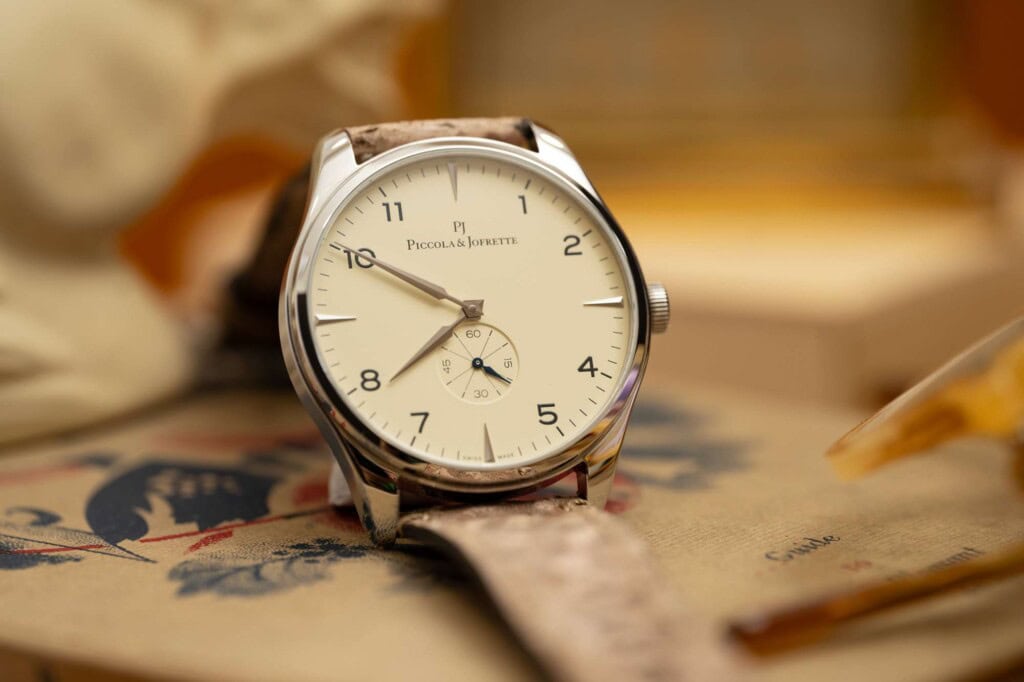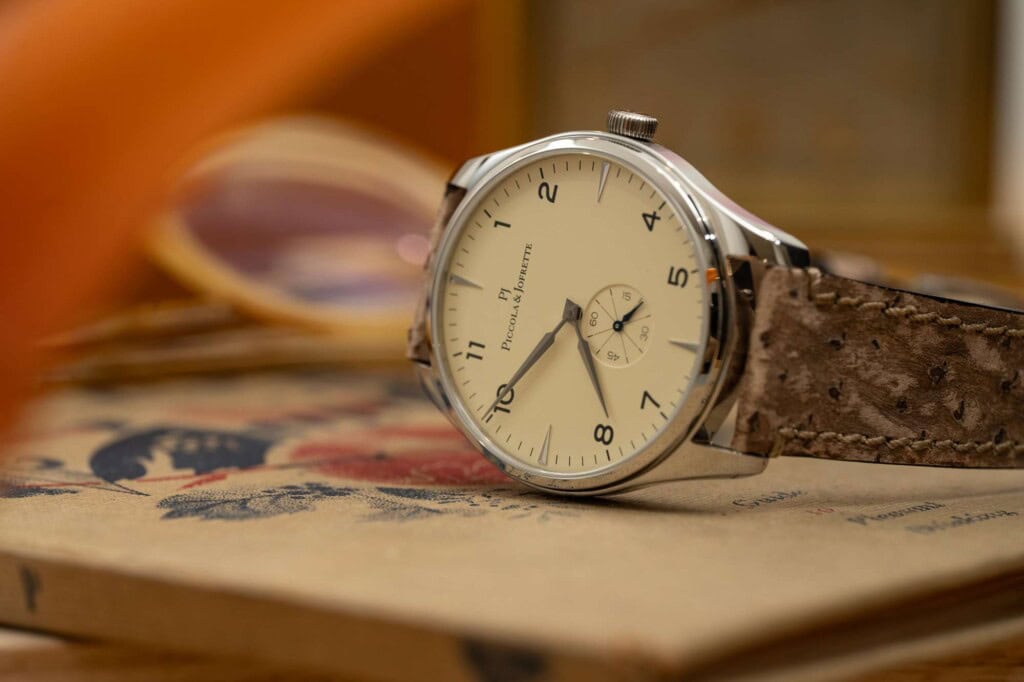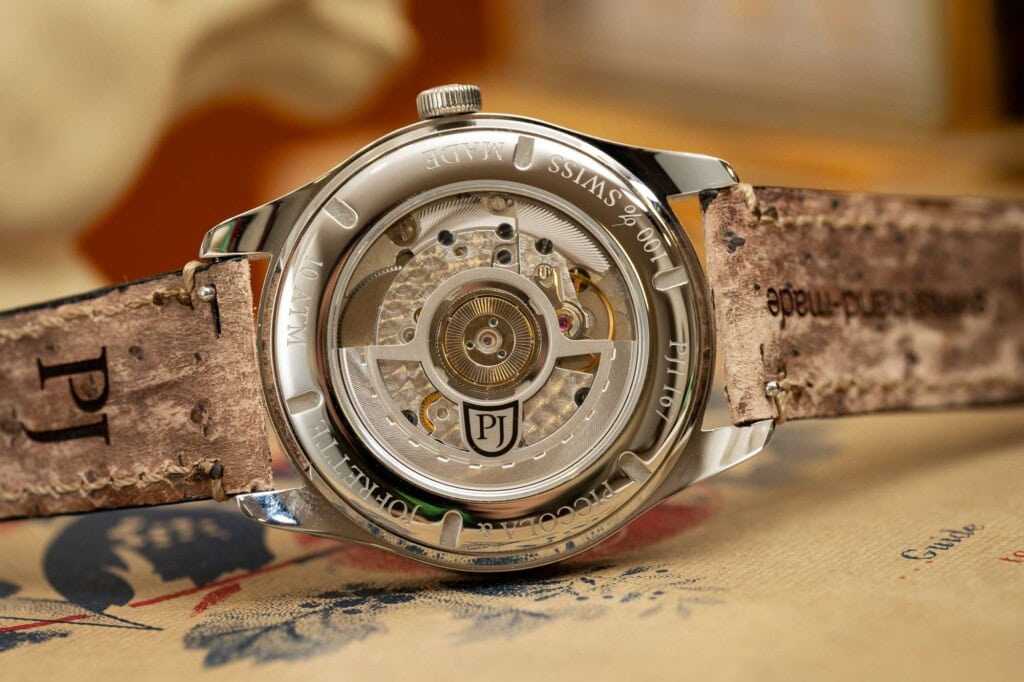It’s not entirely uncommon for my first encounter with a brand to be when they inquire about attending Windup Watch Fairs. There are a lot of brands out there, more every year, so it’s hard to keep up with every new launch. Conveniently, Windup is a great way for new brands to meet enthusiasts and potential customers (sorry, this wasn’t meant to be a Windup pitch), resulting in a natural amount of outreach. When new brands come in, whether to me or a colleague, we give them a quick review to see if they are a conceptual fit for the fair, which they are more often than not.
Occasionally, a new brand will stand out, for one reason or another, and they’ll get the seal of approval and an immediate request for a sample to review. Such was the case with Piccola & Joffrete. What stood out wasn’t the watch’s design, though it is altogether pleasant if conservative; rather, it was what appeared to be a high level of finish and a dedication to Swiss manufacturing.
Many watches say Swiss-made on them, the definition of which I’ll elaborate on below, but few say 100% Swiss-made like the Piccola & Joffretes. Typically, those that are 100% Swiss (which is also hard to tell as transparency isn’t a strength of the watch world) cost significantly more, likely starting in the five figures. So, the final aspect that made Piccola & Joffrete (PJ) stand out was their relatively reasonable price point, Swissness considered, of 2500 CHF.
There are several criteria a watch must meet to have “Swiss-made” or “Suisse/Swiss” on the case or dial. As of 2017, at least 60% of the production cost of the watch must be attributed to Switzerland, the movement must be Swiss-made, and engineering, assembly, and QC must take place in Switzerland. Furthermore, the movement must meet a similar 60% value attributed to Switzerland. Often, in watches of a certain price point, likely 10k and below, the movement accounts for the bulk of that 60%, if not all or more, and thus the rest of a watch is made abroad as manufacturing in Switzerland is far more expensive as labor is expensive, and I would assume, geared towards smaller production runs. Mind you, this 60% is cost, not retail price.
Hands-On with the 100% Swiss-Made Piccola & Jofrette PJ1
Stainless Steel
ETA 2895-2
Eggshell
No
Sapphire
Sturgeon Leather
100m
39 x 46.6mm
9.6mm
20mm
Push/Pull
Yes
$2700
Typically, brands don’t list the origins of each major component (case, dial, hands, etc…) other than the movement, so it’s hard to determine as a consumer whether a watch you’re looking at is closer to that 60% minimum, or 100%. But, to be clear, the notion that a 100% Swiss-made watch is superior to a 60% doesn’t have merit. Chances are, most of the “Swiss-made” watches in our collections are not 100% (including those from large brands we might associate with being Swiss) but are excellent regardless.
At a certain point, I believe, it’s a matter of justifying a higher price, working with specialty manufacturers such as a dial maker known for a certain skill, and simply a desire to work with and support local suppliers. There are also concerns about sustainability that are addressed by working locally. With that in mind, the significance of PJ’s 100% Swiss-made claim should be clear. But it’s also one that needs some backing up.
As said, brands don’t usually say where each component comes from, but PJ does, within reason (they don’t name their suppliers but rather their locations). To that end, everything is Swiss and made within 70km of their Biel/Bienne headquarters. And yes, that means everything. The hands are from Grenchen, the dial is from Le Locle, and the case is from La-Chaux-de-Fonds, so on and so forth. They go beyond the expected components as well, with Swiss-made Swiss ash wood boxes and even Swiss-tanned, Swiss-origin deer and sturgeon (more on that later) Swiss-made straps. Even the Swiss cheese in their cafeteria is Swiss (this is a joke, but also probably true).
The Swissness is impressive, for sure, but to reiterate, while there are other 100% Swiss-made watches out there, it is highly unlikely they cost 2500 CHF (about $2,730 at the time of writing), which is the truly uncommon bit. Of course, none of this would matter if the watches themselves weren’t appealing, which luckily isn’t the case.
The first line of watches is called, unsurprisingly, the PJ1. A mid-century dress-casual design, like the source of its parts, has a Swiss feel, which is to say is classically attractive and reserved. The case measures 39mm x 46.6mm x 9.6mm with 20mm lugs, which is a very comfortable size. It’s pleasantly thin thanks to the ETA 2895-2 inside (they call it PJ1, but the mark is clear by the balance) and flat sapphire, but it maintains a 100m water resistance, which is great to see.
The shape of the case is traditional and has a fully polished bezel and top surface of the midcase, for a dressy look. The case sides are horizontally brushed with a delicate grain and feature a polished bevel that echoes the downward turn of the lug. An attractive detail, it’s the only bit of flourish to be found. The screw-in display case-back is common in appearance and fully polished with various etched details encircling the window. The highly decorated ETA 2892-2 takes the spotlight with a custom rotor, perlage graining, and blued screws.
The dial of the PJ1 is remarkably straightforward. The version here features a subtle and appealing matte eggshell hue with more nuance than pure white. The hour index features applied faceted triangular markers at 3, 6, 9, and 12, with pad-printed numerals in between. The typography here is interesting. It’s a relatively wide sanserif with the occasional unique detail, such as chamfered corners on the 4 and 7 and right-angled overhangs on the 1s. It feels very mid-century in style and brings a casualness that slightly competes with the more formal elements.
A minute index of simple black marks lines the edge of the dial, getting thicker at intervals of five. Both the numerals and marks are very well printed, with sharp edges that hold up under a loupe and a nice build of ink, giving them dimensionality and luster. Just below the hand stack at six lies a stepped-down sub-seconds dial.
Because of the movement design, the subdial is quite close to the dial’s center. Given the overall size of the watch and dial, it’s awkward, coming off too small and feeling off-center between the hands and marker at 6. Additionally, it is packed with graphics, featuring numerals at the quarter minute with hash marks and lines that crisscross the center of the subdial. While an appealing design that keeps with the mid-century aesthetic, its density draws attention, focusing on the awkwardness.
The hour and minute hands are an elegant take on lancets with long stems, geometric ends, and a crease at their centers for a faceted look. They are Rhodium-plated and polished, catching light along with the applied markers for a nice effect. The sub-seconds hand is a similar shape in dark blue that resembles tempered metal. However, they call it “metallic blue,” suggesting it is a coating.
The PJ1 is available on either a deer or sturgeon leather strap, the latter of which is shown here. In terms of Swissness, their description of this strap is delightfully specific: “made from sturgeon sourced from Frutigen (Switzerland), tanned in Steffisburg (Switzerland), and finally hand-stitched into finished watch straps in Riedbach (Switzerland).” It doesn’t get more Swiss than that. In terms of the strap, well, sturgeon is definitely an odd material.
Aesthetically, it looks like a cross between ostrich, cork, and camo, featuring a marbled pattern throughout with the occasional darker spot. The color is a curious faded brown that is atypical for leather; perhaps I’d call it “bark brown.” I’m not sure if it was tanned to be this color or if it’s the natural color of sturgeon. Regardless, it’s cool looking and pleasantly different. My only issue with the strap is the texture. It’s stiff and rough compared to calf leather. While it might break in more over time, they used a fold-over construction for the strap, so the backing is sturgeon too, and it’s not great against skin.
The PJ1 wears well on the wrist. It’s a very nice size for a contemporary everyday watch. 39mm is a sweet spot that will likely fit many wrists, and being under 10mm thick makes it feel more compact. That said, given the mid-century styling of the dial and the sub-seconds issue, a smaller diameter would have been welcome. As is, it would be perfect for a center-seconds version.
As you can tell from this article, there are two conversations to be had around Piccola & Joffrete: one about its watches and the other about its Swissness. Between the two, it’s the latter that’s more compelling. The PJ1 is a perfectly nice watch and one that some could clearly enjoy if the looks suit them, but it lacks personality and, at least for my designer eyes, could use some rebalancing. The fact that it’s 100% Swiss-made adds to its charm and value, though changes nothing about the wearing or aesthetic experience.
Swiss-made is clearly a strong selling point for many brands, especially in retail; the term equates to quality in many people’s minds. I think that’s less the case for watch enthusiasts as we have more experience with watches from all over the world. It’s really that it’s rare to find a 100% Swiss watch from a brand that is fairly transparent about their sourcing (more than most), and doesn’t cost a disproportionate amount more for the badge. While 2500 CHF isn’t cheap, it doesn’t feel exorbitant either. That said, it’s a very competitive segment. Will being 100% Swiss give PJ the Swiss edge they need? Piccola & Jofrette
The post Hands-On with the 100% Swiss-Made Piccola & Jofrette PJ1 appeared first on Worn & Wound.









